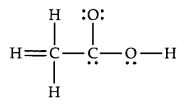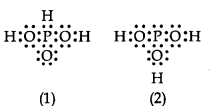

Explain with the help of suitable example polar covalent bond.
When two atoms with different electronegativity are linked to each other by covalent bond, the shared electron pair will not in the centre because of the difference in electronegativity. For example, in hydrogen flouride molecule, flouride has greater electronegativity than hydrogen. Thus, the shared electron pair is displaced more towards’flourine atom, the later will acquire a partial negative charge (∂–). At the same time hydrogen atom will have a partial positive charge (∂+). Such a covalent bond is known as polar covalent bond or simply polar bond.
It is represented as

Match the species in Column I with the geometry/shape in Column II.
| Column I | Column II |
| (i) H30+ | (a) Linear |
| (ii) HC = CH | (b) Angular |
| (iii) Cl0–2 | (c) Tetrahedral |
| (iv) NH+4 | (d) Trigonal bipyramidal |
| – | (e) Pyramidal |
Which of the following statements are correct about CO32- ?
(a) The hybridization of central atom is sp3.
(b) Its resonance structure has one C – O single bond and two C = O double bonds.
(c) The average formal charge on each oxygen atom is 0.67 units.
(d) All C – O bond lengths are equal.
Match the shape of molecules in Column I with the type of hybridization in Column II.
| Column I | Column II |
| (i) Tetrahedral | (a) sp2 |
| (ii) Trigonal | (b) sp |
| (iii) Linear | (c) sp3 |
Account for the following:
(i) Water is a liquid while H2S is a gas
(ii) NH3 has higher boiling point than PH3.
In which of the following substances will hydrogen bond be strongest?
(a) HCl
(b) H20
(c) HI
(d) H2S
Using molecular orbital theory, compare the bond energy and magnetic character of 0+2 and O–2
The skeletal structure of CH3COOH as shown below is correct, but some of the bonds are shown incorrectly. Write the correct Lewis structure for acetic acid.

Which hybrid orbitals are used by carbon atoms in the following molecules?
(a) CH3-CH3 (b) CH3-CH = CH2 (c) CH3-CH2-OH (d) CH3-CHO (e) CH3COOH.
Name the two conditions which must be satisfied for hydrogen bonding to take place in a molecule.
3PO3 can be represented by structures 1 and 2 shown below. Can these two structures be taken as the canonical forms of the resonance hybrid representing H3PO3? If not, give reasons for the same.

(a) How many a and n bonds are present in

(b) Why Hf is more stable than H2?
(c) Why is B2 molecule paramagnetic?
What is an ionic bond? With two suitable examples explain the difference between an ionic and covalent bond?
What is meant by hybridisation of atomic orbitals? Describe the shapes of sp, sp2, sp3 hybrid orbitals.
Describe the change in hybridisation (if any) of the Al atom in the following reaction. AlCl3 + Cl– ——>AlCl4- .
Draw diagrams showing the formation of a double bond and a triple bond between carbon atoms in C2 H4 and C2 H2 molecules.
Explain the diamagnetic behaviour of P2 molecule on the basis of molecular orbital theory.
Why does type of overlap given in the following figure not result in the bond formation?

Predict the shapes of the following molecules on the basis of hybridization. BC13, ch4, co2, nh3
What is meant by the term average bond enthalpy? Why there is difference in bond enthalpy of O – H bond in ethanol (C2H5OH) and water?
Match the species in Column I with the type of hybrid orbitals in Column II.
| Column I | Column II |
| (i) SF4 | (a) sp3cf |
| (ii) if5 | (b) d2sp3 |
| (iii) NO2+ | (c) sp3 d |
| (iv) NH4 | (d) sp3 |
| (e) sp |
Match the species in Column I with the bond order in Column II.
| Column I | , . Column II |
| (i) NO | (a) 1.5 |
| (ii) CO | (b) 2.0 |
| (iii) o–2 | (c) 2.5 |
| (iv) 02 | (d) 3.0 |
Although both CO2 and H2O are triatomic molecules, the shape of H2O molecule is bent while that of CO2 is linear. Explain this on the basis of dipole moment.
Considering X-axis as the intemuclear axis which out of the following will not form a sigma bond and why? (a) Is and Is (b) Is and 2px (c) 2py and 2py (d) Is and 2s
(a) Define dipole moment. What are the units of dipole moment?
(b) Dipole moment values help in predicting the shapes of covalent molecules. Explain.
Describe the hybridisation in case of PCl5. Why are the axial bonds longer as compared to equatorial bonds?
Apart from tetrahedral geometry, another possible geometry for CH4 is square planar with the four H atoms at the comers of the square and the C atoms at its centre. Explain why CH4 is not square planar?